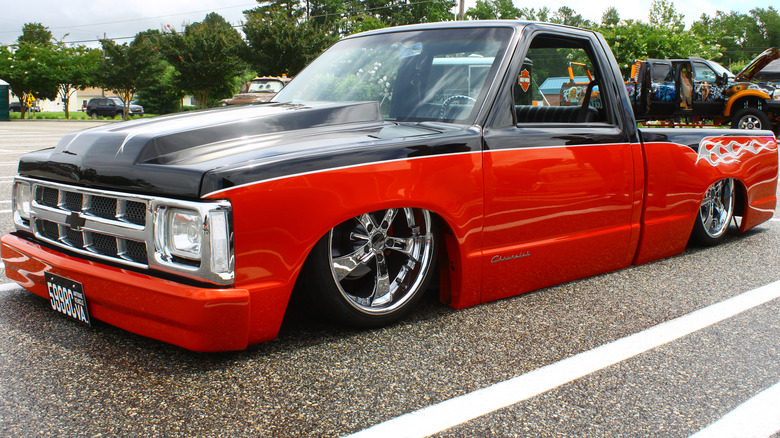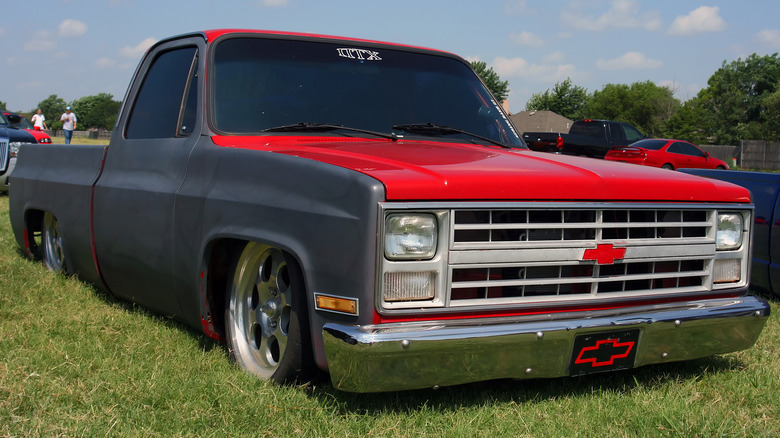Want To Lower Your Truck? Think About These Pros And Cons Of A Dropped Truck First
While lowering a pickup truck may seem like sacrilege for most people, some benefits are worth mentioning. As long as you're okay with not making the most out of your rig's payload and towing numbers, most truck owners slaw their rides to achieve that coveted low-rider vibe, a stance that looks more ravishing in crew cab trucks with extra-long beds. However, for a growing number of enthusiasts, lowering the stock ride height has more to do with that show car look.
According to Motor Trend, lowering a truck improves handling, traction, and aerodynamics, but only if you do it right. Do it wrong, however, and you'll end up with a spine-busting ride that won't do you favors when off-roading or cruising on the highway. The easiest (and most expensive) way to lower a truck is by installing a set of aftermarket hydraulic suspensions or airbags that bring the best of both worlds: Adjustable ride height and customizable damper settings.
But if you're not prepared to spend around $3,000 to $7,000 for a complete air suspension kit, here are the pros and cons you need to know before lowering your truck.
Lowered Truck Pros: Ready for the show
The pros of lowering a truck are similar to the wonders of slamming a car. Not only would lowering the chassis reduce (or eliminate, in some cases) that ugly tire-to-fender gap, but it would make any truck handle better around corners and at triple-digit highway speeds.
Depending on the setup, a lowered truck will have better aerodynamics to improve the range and fuel economy. Moreover, lowering the suspension equates to a lower center of gravity, which is always good if you want sportier handling and an improved road feel.
While an off-road-ready rig with lifted suspension and monster tires looks the business, there's no denying that lowered trucks have a distinctive appeal. That being said, similar to how a daily diet of salty foods and pizza is unhealthy, there are particular drawbacks to consider when lowering a truck. What's interesting is it has more to do with significant chassis problems, and less with the typical scrapes and bumps.
Lowered Truck Cons: How low can you go?
The next best thing to aftermarket air suspension is a comprehensive bolt-on lowering kit that includes higher-rate coil springs and sportier dampers. In addition, the best kind of lowering hardware should consist of custom bushings, tie rods, spindles, control arms, brackets, and other necessary hardware made explicitly for the make and model of your truck. Most lowering kits should reduce the stock ride height of your truck from two to four inches.
Unfortunately, anything lower could result in bottoming the suspension and causing significant damage to the undercarriage when navigating over speed bumps or road undulations. You also risk damaging or deteriorating suspension and steering components like ball joints, tie rods, control arms, driveshafts, and the differential.
Moreover, consider the difficulty of jacking the truck, or how impossible would it be to raise the rig with a jack to replace a flat tire. Plus, a poorly-executed lowering (cutting the stock springs without replacing the dampers, etc.) could enhance accelerated tire wear, or introduce new problems like unnecessary rubbing or binding when turning the wheel.
If you have a newer truck, it's also worth noting that you'll possibly void the new vehicle warranty if you replace the stock suspension.


